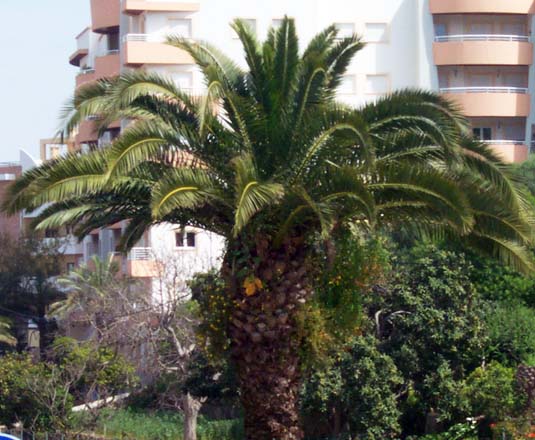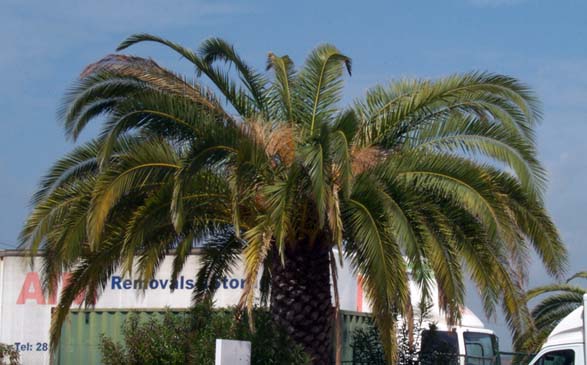
Buying an Aljezur farmhouse
Aljezur farmhouses for sale
Algarve west coast climate; the best weather in Europe?
Contact
Odeceixe beach
Control of the red palm weevil
Vicentina natural park wildlife
Heating options
The truth about coastal property
What is natural park Costa Vicentina?
Building and renovating in western Algarve
Portugal land scams
Fishing on the Vicentina coast
Western Algarve agriculture
AFPOP
Utilities in Portugal
Schools in Aljezur
Solar home heating plans
Pesticide pumps and sprayers
Chemical control;
Page updated February 28, 2014
Despite a lot of effort, I've been unable to get really reliable information on best practice for pesticide application for prevention of red palm weevil , Rhynchophorus ferrugineus Olivier. If any company doing this work will share their knowledge with me, I'd be happy to ad a link to your webpage for those who want to hire a professional to do their work.
Some shops recommend a very small concentration, less than 1% of what other shops tell me.
Adubopor in Portimao recommends a regime for the prevention of the weevil that's simply impossibly strong, but they have the best prices I've found in the algarve.
Fertizur in Aljezur says use 150ml of mixed pesticide in 100 liters of water; this seems very weak to me, yet they told me that their customers are getting good results. One webpage I found suggests 1ml per liter, close to what I've settled on.
For the last year or so, I've settled on this regime; 150ml of Imidacloprid [Also known as Confidor] 18% concentrate, and 150ml of another contact insecticide, Cythrin, [Cypermethrin] in 120 liters of water. I repeat every 8 weeks; some authorities say every 6 weeks, others say only every 12 weeks.
Do this for all your vulnerable palms, which for us means mostly Canary date palms and Washingtonias.

This solution has to be slowly dribbled into the crown of the tree, right between the top leaves, so it soaks into the trunk [and doesn't spill down the outside].
The shop in Portimao also recommended I use a fertilizer in the mixture, but I think that has caused damage to the palm leaves so I've discontinued it.
It takes a lot of fluid; if you don't use enough, the top of the tree may be protected while weevils borrow into the lower trunk. Then the whole tree, still looking fine, just topples over one day.
After some experimentation, I now I use about 5 liters of pesticide mix for every year of growth, so for a 5 year old tree, 25 liters, a ten year old tree, 50 liters. It's important that the fluid fills the trunk right to the bottom.
If you water your trees, stop irrigating a few days before treatment, so it dries out a little and is ready to absorb fluid.
If the mixture comes seeping out of the bottom of the tree [not dribbling down the outside] then you can be sure it has enough.
I use a hook bent out of a piece of copper tube, connected to a very slow dosing pump that pumps at about 10 liters per hour. You can also use a plant sprayer [backpack type holds 15 liters] and hold the lance there if your trees aren't too high.
Otherwise you need to get a long pole or pipe to reach up with.
another idea is to hang a bucket or barrel from a tripod so it's higher than the delivery point, and gravity feed the mixture in. again, if you have really high trees, this won't be practical, but it will work for many.
The important thing is to get the chemicals into the tree.

This picture shows an apparently healthy palm that may be showing the first sign of infection; the top leaves are slightly short. This tree needs treatment urgently.
Palms aren't woody, they're fibrous inside, like a mass of wet twisted rope. It will absorb the mixture better if it hasn't rained for a week or so.
Other methods of getting pesticide into a tree include digging out a root, cutting it and putting the end into a bad of solution so the tree sucks it up. I don't believe in that one.
Most professionals drill a hole [or several holes] and inject it. This is tricky, and requires a high pressure pump, but the professionals do it this way because it's quick. Also, [forgive my cynicism] the equipment looks impressive and complicated, which is good for buisness.
For tall trees, this could be worthwhile as it might be imposable to get enough in at the top to percolate all the way down. But for trees less than 4 meters [to the leaf center, or crown] I really don't think it makes sense.
The injection method is very quick [minutes instead of hours], but for DIY tree care at your own property, you have plenty of time.
The Imidacloprid is the same insecticide as used in "Advantage" flea and tick drops for pets. It lasts for months and kills bugs that try to colonize your tree.
The Cythrin is more powerful but doesn't last as long, the idea is to periodically mop up anything that managed to survive the imidacloprid.
This stuff is expensive.
Cythrin €47 per liter
Solar [or other brand imidacloprid concentrate] €88 per liter
All + 6% tax.
So 120 liters of solution will cost you about €21, and you need that for a few medium sized trees every 8 weeks. if you have a lot of trees, this is really going to add up. But it's nowhere near the huge cost [€250-400 per tree per year] reported in many sections of the press.
The shop also recommends dousing the ground around each tree with another 10 liters of solution. If you have no budget worries, why not? But my opinion is that this 10 liters will only have minimal effect against bugs that don't live on or in the ground.
I have talked to "the tree doctor" on the phone, but they consider their mix proprietary and don't want to give it away.
If anyone has any information to add I'd be pleased to hear it.
You can also ring your property with pheromone traps.
This is just a bucket with water in it [with a little fruit, like apples, added for flavor]. Hanging above the water from the lid of the bucket is 2 sachets with pheromone, one for the males and one for the female weevils. The bucket has holes in the sides for them to enter; they fall into the water and drown.
The sachets cost about €10 each and last 3 months.
The economics of the traps is hard to determine.
I have stopped using them now, mainly because of the expense. 4 traps is €80 to renew the pheromone each time, and although there have been many weevils killed in the traps, there were lots more that made it to my trees; so I don't see any merit in the traps. If the pesticide I give my trees kills all the bugs, I don't need traps; if it kills 95% of the bugs, my trees still get infected and die. Either way, the traps didn't do anything for me.
The few authorities on this who are successfully holding the weevil at bay from the coconut and date trees of India and the Arabian peninsula, say traps are an important part of weevil defense, but they use them mainly for monitoring over huge areas, which we individuals can't do.

This tree is obviously infected. note the lack of top leaves

This tree has had it; it's entire core has been eaten by weevils. Although it looks largely intact on the outside, it's too late to save it.
So far I have failed to find any recent comparative study of different regimes. I think this is a lot of pesticide and a lot of money to spend; would half as much be nearly as effective? Probably, but I don't want to risk my own trees experimenting.
Please note that I have no training or schooling in these matters, but I've written this page since there is almost no information available on practical pesticide application for palm trees for small holders or gardeners.